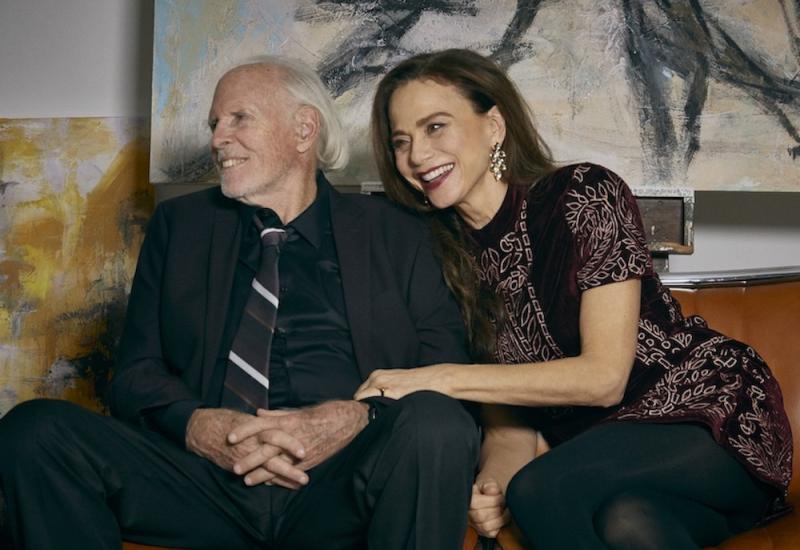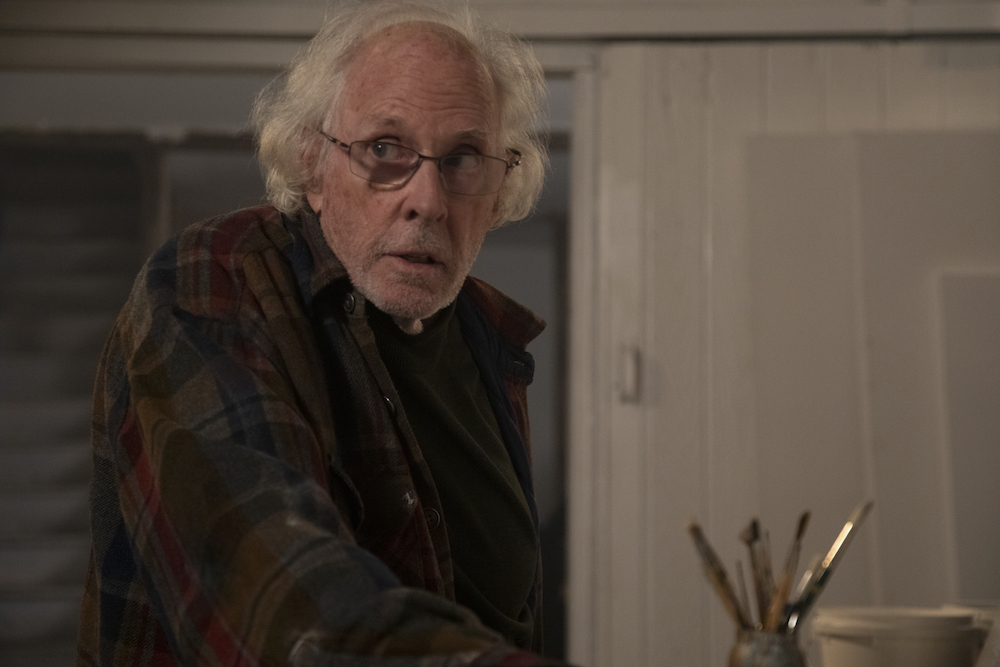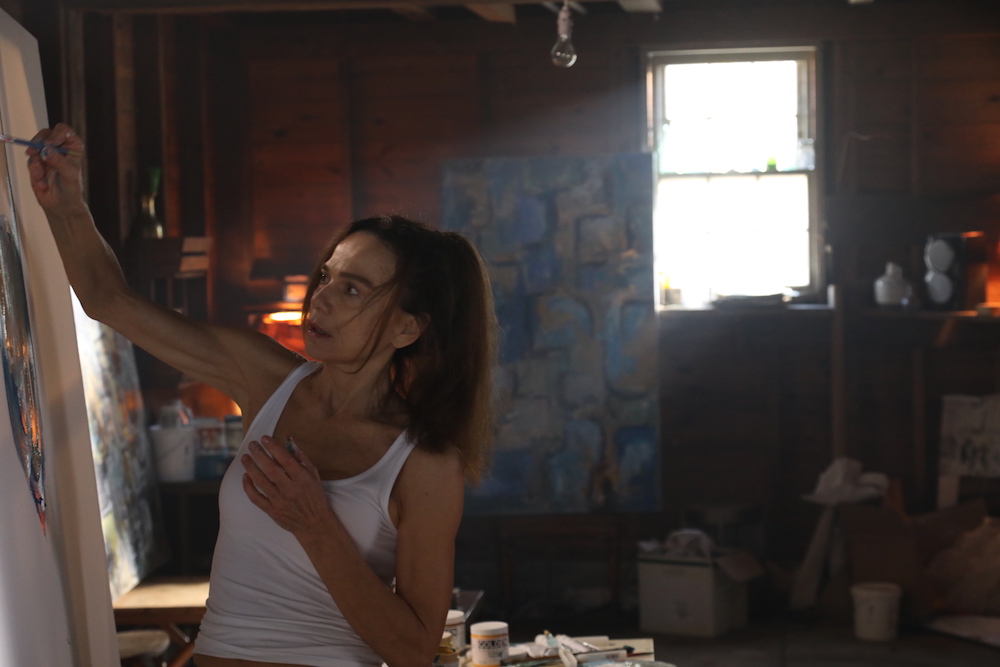The Artist's Wife review - uninspired portrait of dementia in the Hamptons | reviews, news & interviews
The Artist's Wife review - uninspired portrait of dementia in the Hamptons
The Artist's Wife review - uninspired portrait of dementia in the Hamptons
An artist's wife rediscovers her own creativity: Lena Olin and Bruce Dern star

“The only child I’ve ever had is you,” the artist’s wife (Lena Olin), spits at the artist, her considerably older husband (Bruce Dern), who retorts, “That was your goddamn choice so don’t blame it on me.”
Although the setting – a wintery East Hampton – is gorgeous, this portrait of Richard Smythson, a celebrated abstract artist just diagnosed with Alzheimer’s, and his equally talented wife Claire, who gave up her own painting career in favour of his, never veers far from a well worn path.
It doesn’t bear comparison with Nebraska, where Bruce Dern played another senile old chap so magnificently. Still, it raises questions about what’s normal behaviour and what isn’t, especially for a genius, and how to tell when a cantankerous old bastard turns into a recognisably demented one. And how, when that genius husband is lost to dementia, his wife may find herself again.
But none of these issues is addressed very compellingly by director and co-writer Tom Dolby, whose own father, Ray Dolby, the inventor of Dolby sound, had Alzheimer’s. You never get much sense of what the relationship was like before Richard became ill so it’s hard to mourn its loss, unlike in other films about dementia, such as Away from Her, Still Alice or Viggo Mortensen’s recent Falling, which is, like The Artist’s Wife, rooted in personal experience.
Claire and Richard live in splendour – privilege oozes throughout the film - in a black slab of a modernist house with huge windows. Their marble-counter-topped kitchen is lustrous, their fridge, stacked with perfect produce in rows of plastic containers, is of a pristine quality rarely seen in real life. Even his studio, where he’s trying in vain to produce works for a much anticipated show (his agent, played by Tonya Pinkins, keeps asking awkward questions about progress), looks remarkably spick and span, which contributes to the shallow feel that pervades. Richard is a bully and extremely rude to his young students, smashing a poor sucker’s canvas and asking him to repeat, “My painting is a piece of shit and doesn’t deserve to exist,” but this may be par for the course for all we know. Claire and Richard seem close, even jolly, though chemistry is lacking – or is that because he’s forgotten his Viagra?
Richard is a bully and extremely rude to his young students, smashing a poor sucker’s canvas and asking him to repeat, “My painting is a piece of shit and doesn’t deserve to exist,” but this may be par for the course for all we know. Claire and Richard seem close, even jolly, though chemistry is lacking – or is that because he’s forgotten his Viagra?
Claire spends a lot of time staring wistfully out at the snow and sipping cup after cup of coffee from a fancy machine (though a preview of an old friend’s show at the New Museum provides a distraction, with Stephanie Powers of Hart to Hart in a surprise, Italian-accented cameo). Richard buys a $94,000 clock ("I hope we can return it," mutters Claire, rather mildly under the circumstances) and pours orange juice over his Grape-Nuts.
When she gets the diagnosis from a sympathetic doctor who seems more like a friend (we don’t see Richard’s reaction) she’s in denial, and we feel for her. Lena Olin’s face is always expressive and volatile. “Does everyone have to be normal all the time?” she asks tearfully. When getting his new prescription filled she’s oddly flummoxed by the chip-and-pin card machine, then gets belligerent with an employee at the supermarket after he catches her eating an energy bar before she pays for it. Who’s acting forgetful now?
Don’t do this alone, the doctor tells her. Get the family on board. What family? wonders Claire, as she runs despairingly along a beautiful empty beach. Ah yes – Richard’s bitterly estranged daughter Angela (Juliet Rylance; McMafia, Perry Mason), recently divorced from her wife. Stressed-out Angela lives with their son Gogo (Ravi Cabot-Conyers) in a luxury New York apartment building, complete with doorman and handsome manny/musician named Danny (Avan Jogia).
What she does with these paintings forms the film’s rather lacklustre denouement. “It’s very hard to look inside and paint what’s all gone,” complains Richard, as he stares at a blank canvas. Dolby, who is also a novelist and producer, has said that he sees his film as a tribute to caregivers as well as to female artists who have supported their famous husbands – Lee Krasner, Elaine de Kooning, Dora Maar - but this ambition may be a bit of a stretch. Claire, it seems, has just started to look inside again, and likes what she sees, but it’s hard to muster up much excitement about her reclaiming her future as an artist.
rating
Share this article
The future of Arts Journalism
You can stop theartsdesk.com closing!
We urgently need financing to survive. Our fundraising drive has thus far raised £49,000 but we need to reach £100,000 or we will be forced to close. Please contribute here: https://gofund.me/c3f6033d
And if you can forward this information to anyone who might assist, we’d be grateful.

Subscribe to theartsdesk.com
Thank you for continuing to read our work on theartsdesk.com. For unlimited access to every article in its entirety, including our archive of more than 15,000 pieces, we're asking for £5 per month or £40 per year. We feel it's a very good deal, and hope you do too.
To take a subscription now simply click here.
And if you're looking for that extra gift for a friend or family member, why not treat them to a theartsdesk.com gift subscription?
more Film
 Islands review - sunshine noir serves an ace
Sam Riley is the holiday resort tennis pro in over his head
Islands review - sunshine noir serves an ace
Sam Riley is the holiday resort tennis pro in over his head
 theartsdesk Q&A: actor Sam Riley on playing a washed-up loner in the thriller 'Islands'
The actor discusses his love of self-destructive characters and the problem with fame
theartsdesk Q&A: actor Sam Riley on playing a washed-up loner in the thriller 'Islands'
The actor discusses his love of self-destructive characters and the problem with fame
 Honey Don’t! review - film noir in the bright sun
A Coen brother with a blood-simple gumshoe caper
Honey Don’t! review - film noir in the bright sun
A Coen brother with a blood-simple gumshoe caper
 The Courageous review - Ophélia Kolb excels as a single mother on the edge
Jasmin Gordon's directorial debut features strong performances but leaves too much unexplained
The Courageous review - Ophélia Kolb excels as a single mother on the edge
Jasmin Gordon's directorial debut features strong performances but leaves too much unexplained
 Blu-ray: The Graduate
Post #MeToo, can Mike Nichols' second feature still lay claim to Classic Film status?
Blu-ray: The Graduate
Post #MeToo, can Mike Nichols' second feature still lay claim to Classic Film status?
 Little Trouble Girls review - masterful debut breathes new life into a girl's sexual awakening
Urska Dukic's study of a confused Catholic teenager is exquisitely realised
Little Trouble Girls review - masterful debut breathes new life into a girl's sexual awakening
Urska Dukic's study of a confused Catholic teenager is exquisitely realised
 Young Mothers review - the Dardennes explore teenage motherhood in compelling drama
Life after birth: five young mothers in Liège struggle to provide for their babies
Young Mothers review - the Dardennes explore teenage motherhood in compelling drama
Life after birth: five young mothers in Liège struggle to provide for their babies
 Blu-ray: Finis Terrae
Bleak but compelling semi-documentary, filmed on location in Brittany
Blu-ray: Finis Terrae
Bleak but compelling semi-documentary, filmed on location in Brittany
 Oslo Stories Trilogy: Sex review - sexual identity slips, hurts and heals
A quietly visionary series concludes with two chimney sweeps' awkward sexual liberation
Oslo Stories Trilogy: Sex review - sexual identity slips, hurts and heals
A quietly visionary series concludes with two chimney sweeps' awkward sexual liberation
 Sorry, Baby review - the healing power of friendship in the aftermath of sexual assault
Eva Victor writes, directs and stars in their endearing debut feature
Sorry, Baby review - the healing power of friendship in the aftermath of sexual assault
Eva Victor writes, directs and stars in their endearing debut feature
 Blu-ray: Who Wants to Kill Jessie?
Fast-paced and visually inventive Czech comedy
Blu-ray: Who Wants to Kill Jessie?
Fast-paced and visually inventive Czech comedy
 Oslo Stories Trilogy: Love review - freed love
Gay cruising offers straight female lessons in a heady ode to urban connection
Oslo Stories Trilogy: Love review - freed love
Gay cruising offers straight female lessons in a heady ode to urban connection

Add comment